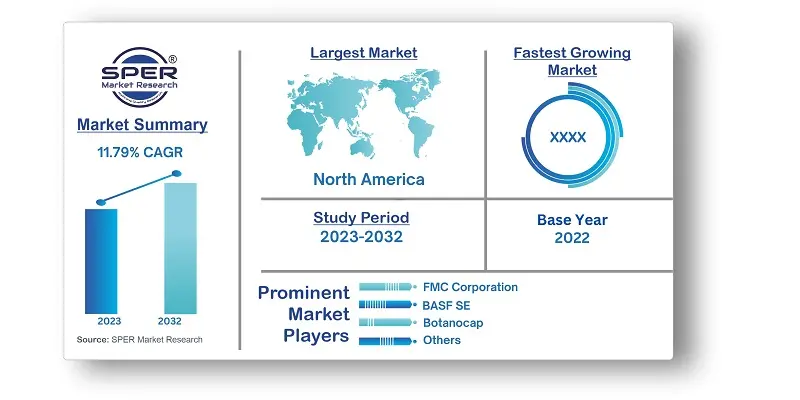
Microencapsulated Pesticides Market Growth, Size, Trends, Share, Challenges and Future Strategies
Microencapsulated Pesticides Market Size- By Type, By Technology, By End User- Regional Outlook, Competitive Strategies and Segment Forecast to 2032
| Published: Mar-2023 | Report ID: CHEM2350 | Pages: 1 - 244 | Formats*: |
| Category : Chemical & Materials | |||
- November 2023: The PilarBio Strategic Upgrade and the Sixth National Strategic Customer Development Conference were conducted in Changsha, Hunan Province, China. PilarBio developed its microencapsulated formulation Pilarcore® and nano-formulation Pilarnano® brands, as well as its brand mascot, "Pilar OX.".
- December 2019: Belchim Crop Protection, a Belgian firm, purchased the American agrochemical company Engage Agro USA, LLC.


| Report Metric | Details |
| Market size available for years | 2019-2032 |
| Base year considered | 2022 |
| Forecast period | 2023-2032 |
| Segments covered | By Technology, By Type, By Application Industry. |
| Regions covered | North America, Asia-Pacific, Latin America, Middle East & Africa and Europe |
| Companies Covered | ADAMA Agricultural Solutions Ltd, BASF SE, Bayer AG, Botanocap, FMC Corporation, GAT Microencapsulation, Israel Chemical Company, K + S Group, Yara International. |
- Manufacturers/ Buyers
- Research Professionals
- Pesticide product traders
- Distributors, and suppliers
- Manufacturers receive technical ingredients and technology from vendors.
- Associations and research organizations
- Agricultural institutes and universities
- Consumers, including farmers
- Government, legislative, and regulatory bodies
| By Technology: |
|
| By Indication: |
|
| By Service: |
|
- Global Microencapsulated Pesticides Market Size (FY’2023-FY’2032)
- Overview of Global Microencapsulated Pesticides Market
- Segmentation of Global Microencapsulated Pesticides Market By Technology (Physical, Physio-Chemical, Chemical)
- Segmentation of Global Microencapsulated Pesticides Market By Type (Insecticides, Fungicides, Herbicides, Rodenticides, Others)
- Segmentation of Global Microencapsulated Pesticides Market By Application Industry (Agricultural and Non-Agricultural)
- Statistical Snap of Global Microencapsulated Pesticides Market
- Expansion Analysis of Global Microencapsulated Pesticides Market
- Problems and Obstacles in Global Microencapsulated Pesticides Market
- Competitive Landscape in the Global Microencapsulated Pesticides Market
- Impact of COVID-19 and Demonetization on Global Microencapsulated Pesticides Market
- Details on Current Investment in Global Microencapsulated Pesticides Market
- Competitive Analysis of Global Microencapsulated Pesticides Market
- Prominent Players in the Global Microencapsulated Pesticides Market
- SWOT Analysis of Global Microencapsulated Pesticides Market
- Global Microencapsulated Pesticides Market Future Outlook and Projections (FY’2023-FY’2032)
- Recommendations from Analyst
1.1. Scope of the report1.2. Market segment analysis
2.1. Research data source2.1.1. Secondary Data2.1.2. Primary Data2.1.3. SPER’s internal database2.1.4. Premium insight from KOL’s2.2. Market size estimation2.2.1. Top-down and Bottom-up approach2.3. Data triangulation
4.1. Driver, Restraint, Opportunity and Challenges analysis4.1.1. Drivers4.1.2. Restraints4.1.3. Opportunities4.1.4. Challenges4.2. COVID-19 Impacts of the Global Microencapsulated Pesticides Market.
5.1. SWOT Analysis5.1.1. Strengths5.1.2. Weaknesses5.1.3. Opportunities5.1.4. Threats5.2. PESTEL Analysis5.2.1. Political Landscape5.2.2. Economic Landscape5.2.3. Social Landscape5.2.4. Technological Landscape5.2.5. Environmental Landscape5.2.6. Legal Landscape5.3. PORTER’s Five Forces5.3.1. Bargaining power of suppliers5.3.2. Bargaining power of buyers5.3.3. Threat of Substitute5.3.4. Threat of new entrant5.3.5. Competitive rivalry5.4. Heat Map Analysis
6.1. Global Microencapsulated Pesticides Market Manufacturing Base Distribution, Sales Area, Product Type6.2. Mergers & Acquisitions, Partnerships, Product Launch, and Collaboration in Global Microencapsulated Pesticides Market
7.1. Global Microencapsulated Pesticides Market Size, Share and Forecast, By Technology, 2019-2025
7.2. Global Microencapsulated Pesticides Market Size, Share and Forecast, By Technology, 2026-20327.3. Physical7.4. Physio-Chemical7.5. Chemical
8.1. Global Microencapsulated Pesticides Market Size, Share and Forecast, By Type, 2019-20258.2. Global Microencapsulated Pesticides Market Size, Share and Forecast, By Type, 2026-20328.3. Insecticides8.4. Fungicides8.5. Herbicides8.6. Rodenticides8.7. Others
9.1. Global Microencapsulated Pesticides Market Size, Share and Forecast, By Application Industry, 2019-20259.2. Global Microencapsulated Pesticides Market Size, Share and Forecast, By Application Industry, 2026-20329.3. Agriculture9.4. Non-Agriculture
10.1. Global Microencapsulated Pesticides Market Size and Market Share
11.1. Global Microencapsulated Pesticides Market Size and Market Share By Region (2019-2025)11.2. Global Microencapsulated Pesticides Market Size and Market Share By Region (2026-2032)11.3. Asia-Pacific11.3.1. Australia11.3.2. China11.3.3. India11.3.4. Japan11.3.5. South Korea11.3.6. Rest of Asia-Pacific11.4. Europe11.4.1. France11.4.2. Germany11.4.3. Italy11.4.4. Spain11.4.5. United Kingdom11.4.6. Rest of Europe11.5. Middle East and Africa11.5.1. Kingdom of Saudi Arabia11.5.2. United Arab Emirates11.5.3. Qatar11.5.4. South Africa11.5.5. Egypt11.5.6. Morocco11.5.7. Nigeria11.5.8. Rest of Middle East & Africa11.6. North America11.6.1. Canada11.6.2. Mexico11.6.3. United States11.7. Latin America11.7.1. Argentina11.7.2. Brazil11.7.3. Rest of Latin America
12.1. ADAMA Agricultural Solutions Ltd.12.1.1. Company details12.1.2. Financial outlook12.1.3. Product summary12.1.4. Recent developments12.2. BASF SE12.2.1. Company details12.2.2. Financial outlook12.2.3. Product summary12.2.4. Recent developments12.3. Bayer AG12.3.1. Company details12.3.2. Financial outlook12.3.3. Product summary12.3.4. Recent developments12.4. Botanocap12.4.1. Company details12.4.2. Financial outlook12.4.3. Product summary12.4.4. Recent developments12.5. FMC Corporation12.5.1. Company details12.5.2. Financial outlook12.5.3. Product summary12.5.4. Recent developments12.6. GAT Microencapsulation12.6.1. Company details12.6.2. Financial outlook12.6.3. Product summary12.6.4. Recent developments12.7. Israel Chemical Company12.7.1. Company details12.7.2. Financial outlook12.7.3. Product summary12.7.4. Recent developments12.8. K + S Group12.8.1. Company details12.8.2. Financial outlook12.8.3. Product summary12.8.4. Recent developments12.9. Yara International12.9.1. Company details12.9.2. Financial outlook12.9.3. Product summary12.9.4. Recent developments
12.10. Others
SPER Market Research’s methodology uses great emphasis on primary research to ensure that the market intelligence insights are up to date, reliable and accurate. Primary interviews are done with players involved in each phase of a supply chain to analyze the market forecasting. The secondary research method is used to help you fully understand how the future markets and the spending patterns look likes.
The report is based on in-depth qualitative and quantitative analysis of the Product Market. The quantitative analysis involves the application of various projection and sampling techniques. The qualitative analysis involves primary interviews, surveys, and vendor briefings. The data gathered as a result of these processes are validated through experts opinion. Our research methodology entails an ideal mixture of primary and secondary initiatives.



Frequently Asked Questions About This Report
PLACE AN ORDER
Year End Discount
Sample Report
Pre-Purchase Inquiry
NEED CUSTOMIZATION?
Request CustomizationCALL OR EMAIL US
100% Secure Payment






Related Reports
Our Global Clients
Our data-driven insights have influenced the strategy of 200+ reputed companies across the globe.






















